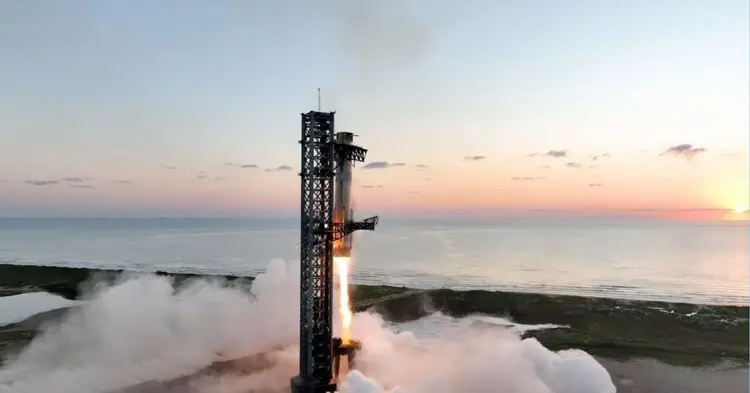SpaceX’s Dramatic Rocket Catch Brings Interplanetary Travel One Step Closer

This article was first published in WIRED Italia and has been translated from its original Italian version.
SpaceX has achieved a significant breakthrough in testing its Starship spacecraft, which is intended for manned missions to the Moon and Mars. After a test launch yesterday, the Super Heavy booster, which propels Starship, successfully landed back on Earth at its "Mechazilla" launch tower. This marked the first successful attempt at this landing technique. This accomplishment brings SpaceX closer to its goal of creating a completely reusable spacecraft system with Starship.
Once the Starship separated after takeoff and used up most of its fuel, the Super Heavy, which stands 70 meters tall, activated 13 of its 33 engines to execute a controlled descent. Afterward, it turned off all but three engines and guided itself onto two metal arms, known as "chopsticks," which SpaceX named, on its launch platform located in Boca Chica, Texas. The entire event, from lift-off to landing on Mechazilla's arms, lasted just 7 minutes.
At the same time, the Starship spacecraft kept flying for roughly an hour after separating from Super Heavy, using its six engines to navigate, before landing in the Indian Ocean.
Starship is the biggest and most potent spacecraft ever constructed, designed to transport astronauts to both the Moon and Mars. Following a series of progressively challenging test flights that started in 2019 with short trials of a prototype called Starhopper, which only rose a few meters into the air, SpaceX has shifted its focus to more advanced testing of the Starship capsule and the Super Heavy rocket.
The latest test prior to yesterday took place in June. During that test, both the rocket and the spacecraft successfully endured re-entry into Earth's atmosphere, overcoming significant challenges. They also practiced landing in the ocean. Super Heavy demonstrated its ability to return to the launch tower by executing a controlled descent to a designated location over the Gulf of Mexico.
SpaceX has successfully landed its Falcon 9 rockets numerous times after their missions, making it a core part of their operations. In contrast, Starship is a significantly more advanced and powerful system compared to the Falcon 9. Featuring 33 engines that produce greater power than those on the Falcon, the Super Heavy booster generates roughly ten times the thrust at launch. This larger and more complex machine presents a greater challenge when it comes to landing.
SpaceX is currently testing Starship, with plans to utilize the Super Heavy booster and the Mechazilla tower to minimize the need for building a new rocket for every launch. This strategy is expected to significantly cut launch costs and increase the frequency of flights. To achieve its objective of lowering the time and expenses involved in transporting cargo and people to orbit and beyond, quick reuse of rockets will be crucial. According to Elon Musk, SpaceX's CEO and founder, the goal for the Super Heavy is to have it back on the launch pad just minutes after its recovery, enabling it to launch again within 30 minutes after being refueled.
Following the successful landing of the Super Heavy, SpaceX is now ready to take on its next task: refueling a Starship in orbit. This step is essential for transporting one of these vehicles to the Moon.









































